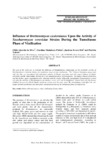Use este identificador para citar ou linkar para este item:
http://www.alice.cnptia.embrapa.br/alice/handle/doc/882297Registro completo de metadados
| Campo DC | Valor | Idioma |
|---|---|---|
| dc.contributor.author | SILVA, G. A. da | pt_BR |
| dc.contributor.author | POLETTO, C. M. | pt_BR |
| dc.contributor.author | POLI, J. S. | pt_BR |
| dc.contributor.author | VALENTE, P. | pt_BR |
| dc.date.accessioned | 2011-04-10T11:11:11Z | pt_BR |
| dc.date.available | 2011-04-10T11:11:11Z | pt_BR |
| dc.date.created | 2011-03-23 | pt_BR |
| dc.date.issued | 2011 | pt_BR |
| dc.identifier.citation | Brazilian Archives of Biology and Technology, Curitiba, v. 54, n. 2, p. 347-356, mar./abr. 2011. | pt_BR |
| dc.identifier.uri | http://www.alice.cnptia.embrapa.br/alice/handle/doc/882297 | pt_BR |
| dc.description | The aim of this work was to evaluate the influence of Brettanomyces custersianus on the metabolic activity of Saccharomyces cerevisiae during the tumultuous stage of wine production. The Cabernet Sauvignon grape must with the skin was inoculated with individual cultures of Sacch. cerevisiae and with mixed cultures of Sacch. cerevisiae and Br. custersianus. During the 6-day tumultuous phase of fermentation, the highest ethanol production and the highest sugar consumption were obtained with the strains without B. custersianus. Fermentations carried out with the addition of Brettanomyces metabolites, acetic acid and 4-ethylphenol, showed that only the former inhibited the growth of both Sacch. cerevisiae strains used. In some cases, Br. custersianus could affect the rate higher alcohols production and their final concentrations during the tumultuous phase of vinification. | pt_BR |
| dc.language.iso | eng | eng |
| dc.rights | openAccess | eng |
| dc.subject | Vinificação | pt_BR |
| dc.subject | Brettanomyces custersianus | pt_BR |
| dc.subject | Influência | pt_BR |
| dc.subject | Levedura | pt_BR |
| dc.title | Influence of Brettanomyces custersianus upon the activity of Saccharomyces cerevisiae strains during the tumultuous phase of vinification. | pt_BR |
| dc.type | Artigo de periódico | pt_BR |
| dc.date.updated | 2019-04-12T11:11:11Z | pt_BR |
| dc.subject.thesagro | Microbiologia | pt_BR |
| dc.subject.thesagro | Enologia | pt_BR |
| dc.subject.thesagro | Vinho | pt_BR |
| dc.subject.thesagro | Fermentação | pt_BR |
| dc.subject.thesagro | Saccharomyces Cerevisiae | pt_BR |
| riaa.ainfo.id | 882297 | pt_BR |
| riaa.ainfo.lastupdate | 2019-04-12 -03:00:00 | pt_BR |
| dc.identifier.doi | 10.1590/S1516-89132011000200017 | pt_BR |
| dc.contributor.institution | GILDO ALMEIDA DA SILVA, CNPUV; Carolina Madalozzo Poletto, CNPUV (bolsista); Jandora Severo Poli, CNPUV (bolsista); Patricia Valente, UFRGS. | pt_BR |
| Aparece nas coleções: | Artigo em periódico indexado (CNPUV)  | |
Arquivos associados a este item:
| Arquivo | Descrição | Tamanho | Formato | |
|---|---|---|---|---|
| silva2011347.pdf | 198.8 kB | Adobe PDF |  Visualizar/Abrir |









